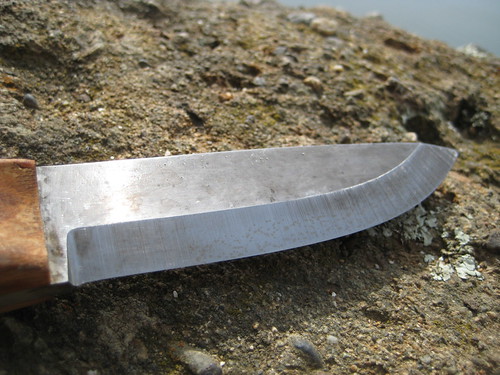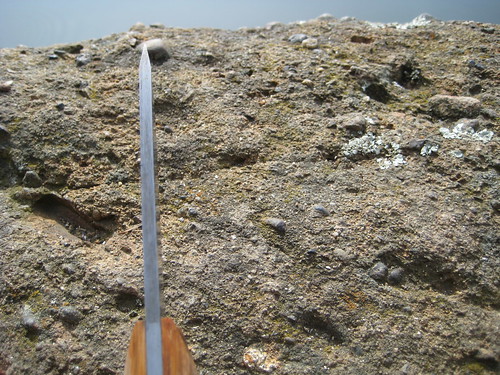Patina
High carbon steels have a tendency to rust without proper care. This is especially true of knives made from O1 tool steel, such as my BCNW-O1.
A patina is a thin film that develops on some metals due to oxidation. It is a type of rust, but a good one, that protects the blade rather than corroding and eating away at the metal. Over time, most knives will develop a patina, regardless of the material that they’re made from. Many people are attracted to the distinctive and aged look that a patina imparts onto a knife, and will make an effort to force a patina onto their blades. The easiest way to do so is to use the knife to prepare acidic foods: potatoes, onions, tomatoes, pickles, and the like all work well. Some people will soak a rag in vinegar and wrap it around the blade, or coat the blade with mustard and leave it overnight.
I wanted to force a patina onto my BCNW-O1, for both the aged look and the extra protection that it gives. The first step I took was to take a slightly-moldy potato out of my fridge and stab the blade into it, up to the handle. I left this in overnight. In the morning, I took the blade out, rinsed it, and stabbed it into another spot on the potato. I repeated this through-out the day, leaving the blade in one spot for a few hours at a time. This sort of approach adds a multi-layered texture to the patina.
After the blade had been in and out of the potato for about 24 hours, I tossed the potato, cleaned the knife, and used it to slice an orange. After the orange was sliced, I left the knife on the plate with the orange as I ate, so that the juices could soak into the blade a bit. After this, I rinsed and dried the blade again, then sliced another orange the next day.
I figured all of this would probably be good enough, so, after slicing the final orange, I rinsed the blade once more, then gave it a good scrubbing with a soapy sponge to clean off any bacteria that might be growing on it after all the exposure to food. This removed a lot of the rust – more than I thought it would – but, after I dried the knife off, I had a beautiful patina on the blade.
Since the patina is a type of rust, it does eat away the sharp edge of the knife a bit. So, after it was all clean, I gave the knife a session on my 6000 grit japanese water stone, which sharpened it back up again.
Usually after the sharpening the knife, I coat it in camellia oil, which was used in Japan by samurais to protect their blades. It is a non-toxic oil that is often used for skin care, and can even be cooked with, so I have no problem using it on a knife that I will prepare food with and eat with. The main purpose of the oil is to protect the blade from rust so, with the patina applied, it is not strictly as necessary as before. Still, I apply it so that both it and the patina can ward away any bad rust.
Using a fine-grit Japanese water stone with a nagura stone to sharpen the blade creates a slightly abrasive cleaner that can be purposefully rubbed into the blade to clean off the beginnings of a patina, if one so desires. I do not do this on purpose, but I have sharpened my knife multiple times since applying the patina and, as a result, the bevel of the blade is much shinier and less-rusted than the upper part.
You can tell this patina is forced, because it terminates at the handle (I couldn’t stab it into the potato any deeper!) of the BCNW-O1. The exposed part of the tang is shiny clean, like new.

